Let Your Grog Flag Fly!
Recent Articles
GARPA 17, 4/26/13
SimCity AAR Part 1, 4/25/13
Announcing MayViation, 4/24/13
Second Look at Wargame AirLand Battle, 4/21/13
First Look at Wargame AirLand Battle 4/19/13
AAR of Dark Age Minis Battle, 4/18/13
Video Review of Zulus on the Ramparts, 4/14/13
GARPA 16, 4/12/13
Crusader Kings II AAR Part 16, 4/11/13
Book Review: Ninja: 1000 Years of the Shadow Warrior, 4/10/13
Review of Bioshock INfinite, 4/7/13
Review of XFX PRO650W Core Edition PSU, 4/5/13
Civilization V AAR, Part 13, 4/4/13
Fire with Fire, 3/31/13
GARPA 15, 3/29/13
Civilization V AAR, Part 12, 3/28/13
Wheaton INterview, 3/27/13
March Mayhem Winner, 3/25/13
Warlock Multiplayer AAR, 3/21/13
WWII PTO Alternate Histories, 3/20/13
GARPA 14, 3/15/13
Crusader Kings II AAR, part 15, 3/14/13
Civilization V AAR, part 11, 3/7/13
Prezcon Convention Coverage, 3/2/13
Civilization V AAR, part 10, 3/3/13
Click here for our
FULL Article Index
and
Screenshot features |
First Impressions of Bolt Action
by Dan Pinkham
Designer – Alessio Cavatore and Rick Priestley
Publisher – Warlord Games and Osprey Publishing
|
|
With all the miniatures rules out there for World War II gaming, Grogheads' Dan Pinkham looks at the newly released Bolt Action and tells us what sets it apart from the rest of them.
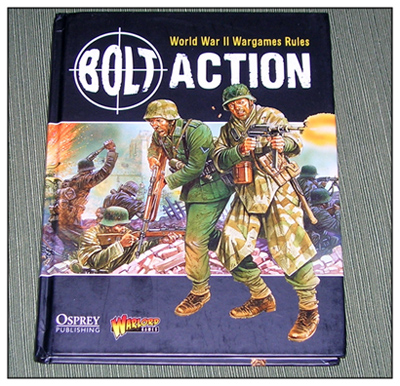 Warlord Games, in collaboration with Osprey Publishing, recently released a set of World War II wargaming skirmish rules entitled Bolt Action. Designed by expert game designers Rick Priestley and Alessio Cavatore and with the weight of the publishers behind it, I knew I had to pick up a set of these rules. My copy arrived in the mail this week and I have had a chance to sit down and give the rules a read through. Unfortunately I have not had a chance to get some figures together and play a game with the rules, so the following impressions are derived from a read through of the rules. Warlord Games, in collaboration with Osprey Publishing, recently released a set of World War II wargaming skirmish rules entitled Bolt Action. Designed by expert game designers Rick Priestley and Alessio Cavatore and with the weight of the publishers behind it, I knew I had to pick up a set of these rules. My copy arrived in the mail this week and I have had a chance to sit down and give the rules a read through. Unfortunately I have not had a chance to get some figures together and play a game with the rules, so the following impressions are derived from a read through of the rules.
The first thing that stuck me about Bolt Action is the quality of the rule book itself. It is a hardback book that is excellently bound and should stand the test of time as I learn and play the game. Although slightly smaller in dimensions than your standard rule book, the saying “size doesn’t matter” applies here. Upon opening the rule book you are greeted with 216 glossy pages of wargaming goodness. Almost every page contains some sort of picture of miniatures in action or art work that does nothing less than inspire you to go out, purchase figures, and start playing immediately. Fans of Osprey Publishing will recognize many of the full and half page works of art that adorn each chapter as those from Osprey Publishing’s many military history books. The pictures of miniatures in action show off the great line of WWII miniatures that Warlord Games offers and add great atmosphere to the rule book.
It is all well and good that the rule book looks pretty but what does it have under the hood? The book starts with an extensive table of contents, which is helpful because the rules do not contain an index. This table of contents breaks down each chapter into sections, all of which are referenced with page numbers. The sections are labeled intuitively so that during the run of a play, if a question comes up the answer can be easily located. The first 106 pages give the explanation of the rules with the remaining pages giving scenario framework, force selection guidelines, four army lists, WWII timeline, and two appendixes.
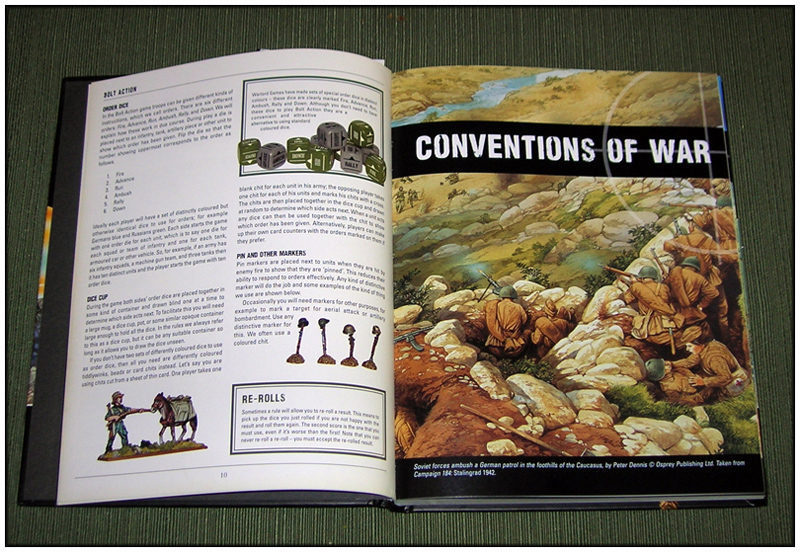
Most wargamers will find things in the introduction and the explanation of the rules to be tried and true concepts that are nearly universal to wargaming, such as rating different types of weapons, cover, damage, etc. The rules are written with 28mm figures in mind but can be used in any scale the gamer chooses. Again the corresponding range and movement value concepts will be nothing new to tabletop minis wargamers. The rules include several well diagrammed examples which make understanding the written text that much easier. The tables and charts included throughout the rules are all repeated at the end of the book in a rules summary section. The rules also contain army lists for the Germans, Americans, British, and Russians. Expanded army lists will be available in separate Bolt Action supplements. In sum: the basic wargaming conventions that miniature gaming enthusiasts expect to be in a set of rules are there. So then, what makes Bolt Action stand out in a market already crowded with WWII miniature gaming rules?
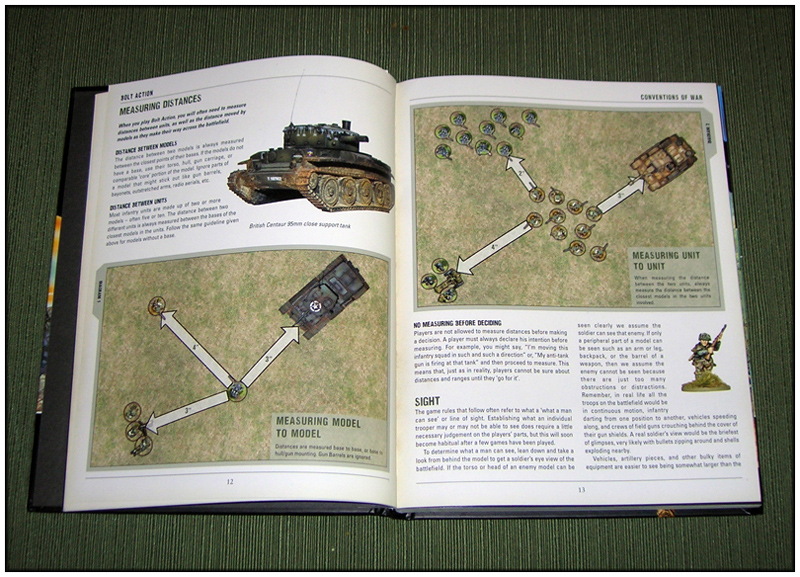
With only having read through the rules, two things jump out that make the Bolt Action rules unique: the activation system and the pinning mechanic. Many wargamers are used to moving all their units, then letting the opponents do the same before moving on to the next turn, with the occasional activation roll to see who moves first. There are even some games where one player moves one of his units, then the other player moves one of his and so on until both sides have used all their units. Not so in Bolt Action. At the beginning of the game each player places an order die, counter, or chit, one for each of his ‘units’ into a cup or other such container (each player has a color or design that differentiates their side’s tokens). These are your order activation tokens or dice. In Bolt Action a ‘unit’ is considered an infantry squad, weapons team, vehicle, or HQ figure. You can never gain more activation tokens, but when one of your units is destroyed, you lose their corresponding order token.
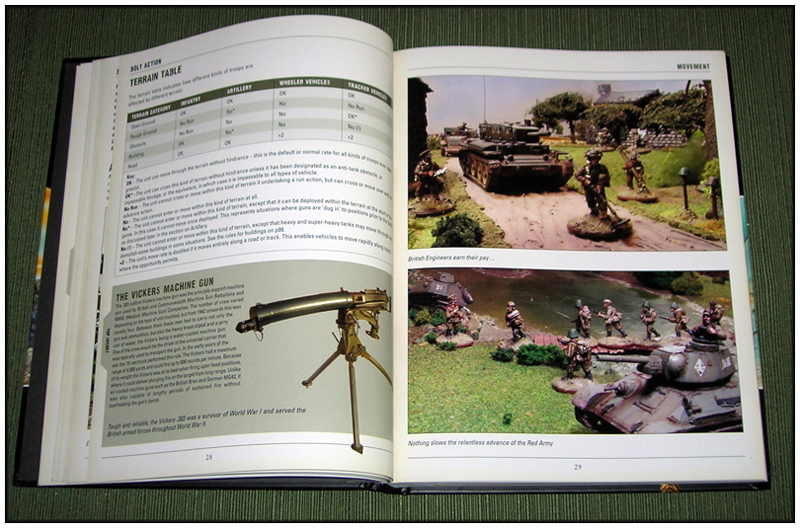
Each turn these order tokens are drawn blindly from the container, one at a time. Whichever player’s token is drawn, he can use it to activate and issue one of six orders to any one of his inactivated units. The six possible orders are fire, advance, run, ambush, rally, or down. After all the tokens have been drawn and orders issued the turn is over. Then all the order tokens for the player’s remaining units are put back into the container to be drawn during the next turn. On the surface this may seem like just a way to add some randomization into who gets to move their units. However, when you dig a little deeper you begin to see the possible tactical implications of losing order dice or drawing consecutive order dice from the container. This unique activation system seems like a great way to add depth to your miniature gaming experience. However, final judgment will have to come after I have played several games with this system.
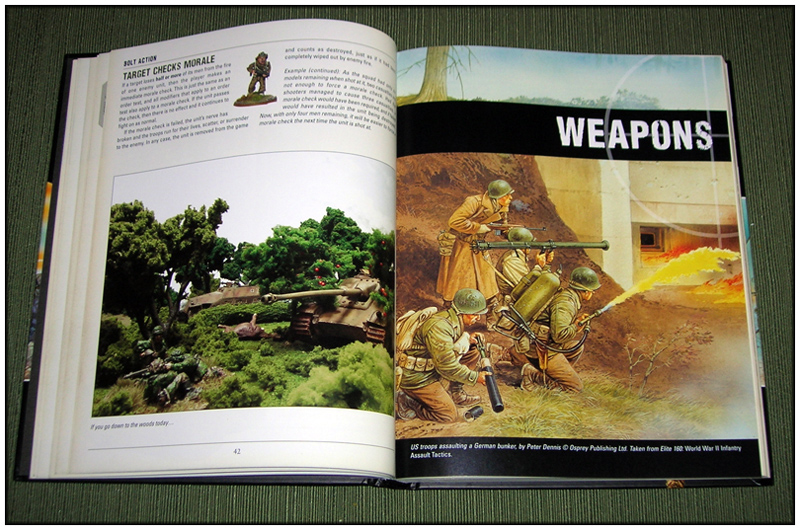
The second interesting feature in the Bolt Action rules is the pinning system. I think the rules speak well for themselves introducing this concept: “Normally, units do what you order them to do without question. However, units that find themselves under enemy fire are less reliable, and sometime they will ignore their orders altogether.” This in essence is the idea behind the pinning system. Whenever a unit receives fire and suffers at least one hit it receives a single pin token. Other enemies shooting at this unit can also inflict a single pin token for one or more hits. The idea being that the more fire a unit receives from different sources the more likely it is to become pinned down. So what does a pin marker do? Effectively it reduces the unit’s morale and in so doing degrades the unit’s ability to follow an issued order. It also negatively affects the unit’s ability to fire effectively at enemy units. When a unit is issued an order, upon drawing their activation die they will automatically follow it if they are not pinned. However, if the unit has one or more pinned markers then it must take an order test to see if it follows the given order.
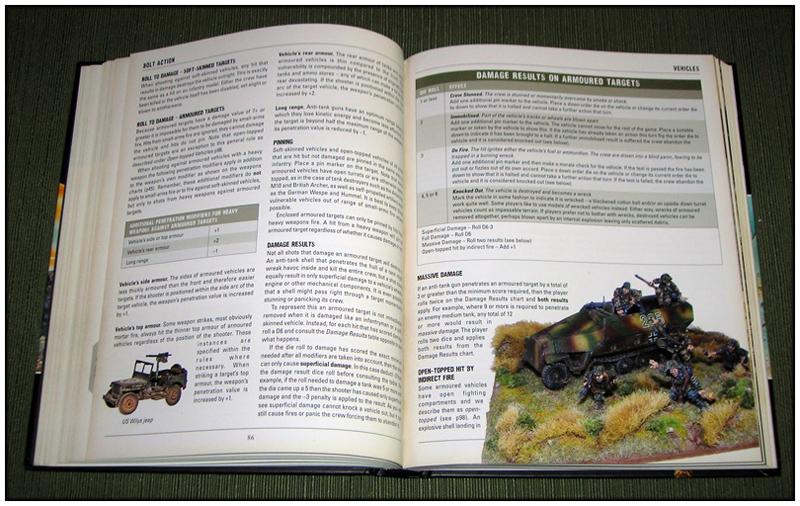
What this means is that the longer a fight goes on the more of a chance one of your units will become pinned and disregard your orders. When I first read about the pinning mechanic, I was not sure if I liked it. It seemed that it would be too easy to pin a unit and effectively eliminate it from the fight. There are, however, ways to reduce pin markers, one of which is by successfully completing an order test. However, going back and reading the mechanics again, I can see how this could model actual combat. In the end, though I do not think it is fair to make a definitive conclusion on the pinning system until I have several games of Bolt Action under my belt. Expect a report soon on this after I've played a few games.
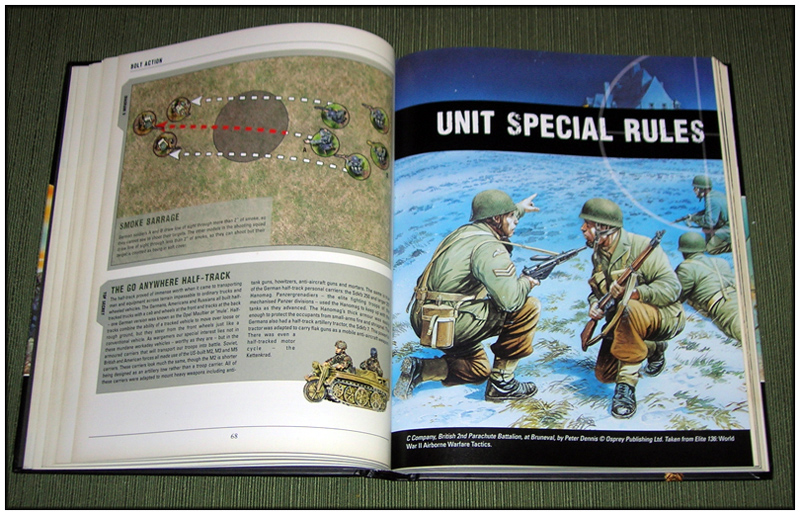
With the caveat of having not actually played a game using these rules, I think I can safely recommend them to anyone interested in World War II skirmish miniature gaming. The quality of the book is to be commended, with the artwork and pictures of miniatures almost worth the price alone. As always, there will be those who are unhappy with glossing over of historical details in order to promote game play. However, where this rule set is forced to do that it tries to explain itself. The debate over playability versus accuracy can tear any game apart but Bolt Action tries to get as much accuracy out of its rules as possible, hence the activation and pinning mechanics. Again a complete conclusion will have to wait until the rules are learned and are tried and test on the field of battle. Until then, I think it is safe to say you will find me feverishly trying to paint up a force to field and try out these rules with.
Discuss this in our forums >>
Recommended Reading
|
Please support the folks that support GrogHeads
|
